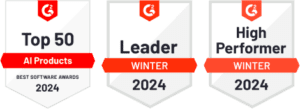Sales machine is a common expression used to describe companies that have built a scalable and predictable sales model.
As such, it is something that encompasses a structure of actions and processes responsible for sustaining the growth of qualified leads that will become customers.
But if we think of a complete machine, we can't just restrict ourselves to the pre-sales and sales sectors. Marketing and Customer Success also play a crucial role within the machine.
So, a spoiler: the sales machine is also about attracting and retaining customers.
And today's article helps you understand what it is, what its structure is and how to create a truly complete, scalable and predictable sales machine in your company. Stay until the end and check it out!
What is a Sales Machine?
In fact, the title could even have been more provocative: "Do you have a sales machine in your company?".
In order to answer this question, you need to understand what it actually consists of. After all, building the machine is synonymous with good processes when it comes to attracting leads and retaining customers.
Therefore, the sales machine must always be:
- Scalable: after all, it feeds back data on leads, customers and teams;
- Predictable: this is because it is crucial to know the origin of your best customers, acquisition channels, conversion rates at all stages, metrics and performance indicators in all funnels, etc;
- Profitable: After all, by understanding where the best opportunities come from, it is possible to focus on them and increase the company's earnings.
What is the structure of the Sales Machine?
In summary, a sales machine is made up of the following funnels.
Marketing funnel
Within CRM, the marketing funnel exists to enrich the lead's data. That's why we can also call it a BDR: Business Development Representative.
This is crucial so that your pre-sales team doesn't waste time looking for information about the lead or approaching people who have nothing to do with the business.
In addition, it's crucial to have integration with a marketing automation platform for mass e-mailing. And also for nurturing leads as soon as rich material has been downloaded from the site, for example.
We can therefore think of four stages for the BDR funnel.
- Registration: Where leads enter through integration with a marketing platform or spreadsheet;
- CNPJ Consultation: With integrations with IRS data, your team can check whether the lead's CNPJ is active;
- Enriching data (partners): Also by integration, your team researches the data of the company's directors;
- Enrich data (credit): check with the institutions whether or not the lead is related to the business.
If all the requirements have been met, it's time to pass the lead on to the pre-sales funnel. If not, discard it.
Pre-sales funnel
In short, the pre-sales funnel has the following stages:
- Incoming leads: stage where leads are automatically distributed to all consultants;
- 1st Contact: "Welcome" to the lead, by e-mail, telephone or WhatsApp Web integrated into CRM via Google Chrome extension;
- 2nd Contact: follows the same terms as the previous stage. However, with a different script;
- 3rd Contact: follows the same terms as the previous stage. However, with a different script;
- Customer qualification: as soon as the lead responds and agrees to talk to the sales team, an appointment is made with the salesperson.
Sales funnel
Within the sales machine, the sales funnel can be structured with the following stages:
- No-show. If the lead doesn't show up for the meeting, the opportunity should be moved here for pre-sales to reschedule the meeting.
- Meeting scheduled. The qualified lead comes in for a call with the sales assistant (closer).
- Sending a proposal. After the call, the salesperson sends the electronic proposal to the lead;
- Follow up. If the lead doesn't respond, the closer asks for a position on the proposal;
- Negotiation. If necessary, a new call can take place;
- Closing. If the lead accepts the proposal via the CRM's electronic signature modulemodule, the sale is sealed here
- Sending a contract. Here, the seller sends a contract for the lead to accept, also electronically.
CS Funnels Onboarding, Ongoing and Contracts
In short, the sales machine is also there to retain customers. Which, in a second step, can lead to expanding the portfolio.
In other words, we're talking about applying cross-selling and up-selling actions to increase the customer's LTV with the company.
Therefore, the focus on onboarding is to ensure that the customer
- you will have implemented what you bought in an agile and didactic manner;
- will see immediate value in what they have acquired;
- you'll get results as soon as possible using the product or service you've contracted.
After being reported as deployed in Onboarding, the Ongoing team takes over. The mission is to see how the product is being used and how the user/customer experience can be improved.
In short, once again the focus is on the customer's success with the brand. And here it can be either using the original solution contracted or adding a new one.
In this sense, "adding something new" is a mission for the CS consultant.
It's up to them to understand the customer's reality and whether a new offer makes sense. Selling just for the sake of selling is not seeking the best for the customer.
Finally, there is the contract funnel. This appears on two occasions:
- For new paying customers, going through the necessary steps to release it for Onboarding to deploy;
- For old customers looking to renew or extend their purchase, as well as to cancel (churn) or contract.
How to Build a Sales Machine in Your Company?
Now that you've seen the structure of the funnels that work to attract, qualify and sell, you need to pay attention to other relevant factors.
The sales machine relies on these funnels to be effective, to produce results and indicators, of course. But there's more to pay attention to.
In short, you need to focus on four aspects:
- Increase the number of leads: As well as giving the pre-sales team more opportunities to work, this is where you'll know what your best customer acquisition channel is;
- Pay attention to indicators: Within the CRM, identify which are your best customers, their regions, common pains, products sold and direct your efforts at them.
- Team and strategy: Train your team based on CRM indicators. Hold weekly training sessions (they don't have to be long), always focused on some pain point in the process;
- Tool: The sales CRM is the sales team's best friend. So choose one that allows you to manage the entire machine: from lead acquisition to customer retention and portfolio expansion.
Thanks for reading this far!
PipeRun CRM is a platform for accelerating sales and managing the entire sales machine, customer acquisition and retention. Visit the site and find out more.
*This guest post was written by the PipeRun CRM marketing team.



